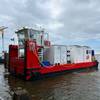Lloyd's Register Designs Software to Monitor Instrumentation
Lloyd’s Register has designed the industry’s first reliability-based mechanical integrity (RBMI) software designed to address the maintenance needs of rotating and instrumentation equipment.
The new modules integrate with the components of Capstone RBMI, allowing companies to combine the maintenance schedules for these types of assets into one program, driving greater efficiency into their processes.
“RBMI programs have been used for many years to evaluate equipment risk and assess inspection and maintenance decisions for fixed equipment. But fixed equipment is just one type of a facility’s assets,” said Andy Scott, Global RBMI Business Director, Lloyd’s Register Americas. “This software recognizes the different maintenance programs needed to test the reliability of rotating equipment and other instrumentation and the controls which have a substantial impact on safety and operational reliability.”
Unlike most fixed equipment, rotating and instrumentation equipment have more diverse sets of components, more varied damage mechanisms and higher variations in damage rates and usage-to-failure times; they require more complex lifecycle assessments and typically come with few guidance documents, all of which makes it difficult to develop an efficient maintenance strategy.
With the Capstone RBMI system, the best maintenance strategy for each piece of equipment is selected by a screening process.
“One of the most beneficial aspects of this pioneering software is that it gives companies access to the kind of streamlined information which creates a more efficient, effective maintenance system by supporting real-time testing, which reduces downtime and increases cost savings,” said Efrain Garcia, Vice-President, Lloyd’s Register Energy Americas.
Additional benefits include identification of critical assets; prioritization of maintenance and/or inspection tasks; fewer equipment failures (which prolongs equipment life, lowers life-cycle costs and increases asset utilization); fewer in-service failures; consistent activity work plans defining recommended preventative maintenance (PM) and corrective maintenance (CM) tasks; directing and systematically documenting the PM and CM activities, using the information to make sound asset-management decisions; systemically records and analyzes failure information to optimize CM and PM strategies; promotes continuous improvement for changing business and operational conditions.










